|
Toyota Yaris / Vitz
Debut: 2005
Maker: Toyota
Predecessor: Yaris / Vitz Mk1
|
|
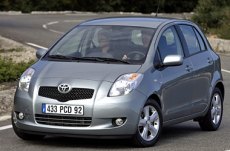 Toyota
had never been good at making small cars until very recently. For
years, its Starlet struggled to break into overseas market but without
much success. It was so frustrated to the extent that it simply took
over Daihatsu in order to gain access to the small car market.
However, in 1999 Toyota finally created a world-class small car. It was
called Vitz at home, or Yaris in Europe and Echo in North America. The
car had a cute styling, very compact yet space-efficient packaging, an
innovative sliding rear seat which could alter passenger legroom and
luggage room according to needs, and it employed a range of 4-valve per
cylinder VVT-i engines to deliver brisk performance. The car won
European Car of the Year award immediately and sold hot in Europe.
Meanwhile, a production plant was established in France - the heartland
of European small cars - as a symbol of victory and rolled out 200,000
Yaris a year. The success of Yaris started a new wave of Toyota
invasion to Europe. After USA, Toyota broke into European market
finally. Toyota
had never been good at making small cars until very recently. For
years, its Starlet struggled to break into overseas market but without
much success. It was so frustrated to the extent that it simply took
over Daihatsu in order to gain access to the small car market.
However, in 1999 Toyota finally created a world-class small car. It was
called Vitz at home, or Yaris in Europe and Echo in North America. The
car had a cute styling, very compact yet space-efficient packaging, an
innovative sliding rear seat which could alter passenger legroom and
luggage room according to needs, and it employed a range of 4-valve per
cylinder VVT-i engines to deliver brisk performance. The car won
European Car of the Year award immediately and sold hot in Europe.
Meanwhile, a production plant was established in France - the heartland
of European small cars - as a symbol of victory and rolled out 200,000
Yaris a year. The success of Yaris started a new wave of Toyota
invasion to Europe. After USA, Toyota broke into European market
finally.
Enough history. Wind forward to February 2005, the second generation
Vitz was launched in Japan. In Europe it is still called Yaris, but USA
and the rest of the world now also adopt the Yaris label. After the
successful Mk1, we inevitably had high expectation on the Mk2. We know
it falls in the most competitive market segment in the world - no less
than 33 cars in AutoZine's comparison list at the time of writing.
Therefore it had better to take another big step forward.
Judging from the exterior styling, my first impression on the Vitz /
Yaris is quite positive. The new car was again designed by Toyota's
Brussels studio, no wonder it preserves the genes of the Mk1. It may be
less radical than the original car 6 years ago, but the design evolved
to be more modern, more flowing and dynamic. Its minimalist cabin looks
very cool, thanks to the contrasting back plastic and silver console.
Like the Mk1, instruments are mounted centrally in the name of allowing
the driver to concentrate on the road. In fact, they allow cheaper
conversion from left to right hand drive.
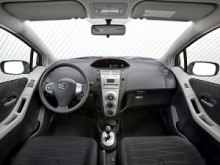 The new
Yaris is considerably larger than its predecessor (110 mm longer, 35 mm
wider and 20 mm taller, plus a 90 mm boost in wheelbase), but it is
still considerably smaller than Renault Clio and Fiat Grande Punto.
Does this mean less cabin space? no. You must admire Japanese
engineers' expertise in packaging. They were born in an environment
where space is as precious as gold, so they were trained to make the
most space out of the minimal exterior dimensions. In the new Vitz /
Yaris, you will find space comparable to Clio. 4 people enjoy plenty of
head and legroom. 5 would be a squeeze though. Although the rear floor
is flat, the body sides are heavily tapered towards the roof. This mean
the outer rear passengers will have their heads rubbing against the
windows or pillars. The same would not happen in our class leader
Mitsubishi Colt. Toyota's engineers know how to solve
this problem - by using boxy body, they gave the smaller Toyota Passo
even more room than the Vitz / Yaris. However, they don't want to
sacrifice the dynamic style and structural rigidity in Vitz / Yaris. The new
Yaris is considerably larger than its predecessor (110 mm longer, 35 mm
wider and 20 mm taller, plus a 90 mm boost in wheelbase), but it is
still considerably smaller than Renault Clio and Fiat Grande Punto.
Does this mean less cabin space? no. You must admire Japanese
engineers' expertise in packaging. They were born in an environment
where space is as precious as gold, so they were trained to make the
most space out of the minimal exterior dimensions. In the new Vitz /
Yaris, you will find space comparable to Clio. 4 people enjoy plenty of
head and legroom. 5 would be a squeeze though. Although the rear floor
is flat, the body sides are heavily tapered towards the roof. This mean
the outer rear passengers will have their heads rubbing against the
windows or pillars. The same would not happen in our class leader
Mitsubishi Colt. Toyota's engineers know how to solve
this problem - by using boxy body, they gave the smaller Toyota Passo
even more room than the Vitz / Yaris. However, they don't want to
sacrifice the dynamic style and structural rigidity in Vitz / Yaris.
Flexible cabin layout is the strength of Yaris. The rear seat not only
6:4 split, recline and fold flat onto the floor, but it also slide back
and forth to alter the distribution between passenger space and luggage
space. Storage space is another strength. There is countless of storage
cubbies throughout the cabin, including a large glovebox in front of
the driver and a drawer underneath the front passenger seat.
Despite of these features, this is not the best cabin in the class.
While its plastics look high quality stuff, once you touch them you
will realize they are just regular hard plastics. Knock them and they
sound hollow. This car does not feel as high quality as Renault Clio
and Volkswagen Polo, although I won't doubt its reliability. Another
disappointment is the cold ambience of the cabin. All plastics are
black, the console is silver and the roof is white. It feels as boring
as the rainy sky of England. Why not inject some colors?
Mechanically, the new Vitz has little to surprise. The front is
suspended by MacPherson struts. The rear by torsion-beam. The chassis
gained 40 percent rigidity over the Mk1. Drag coefficient is reduced to
0.30. All these are predictable. Like the Mk1, it is offered with 3
petrol engines in 1.0 litres, 1.3 litres and 1.5 litres. All of them
employ twin cam 4 valves per cylinder and VVT-i, again like its
predecessor. There is no substantial gain in power, so performance
remains more or less the same.
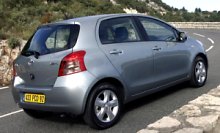 On the
road, the Yaris will be loved for agility and ease of drive. Because of
its efficient packaging, the Yaris can be lighter and more compact than
the latest European mini cars. Its short turning circle makes it easy
to drive in congested urban area. The same goes for the light steering
and crisp gearchange. If motorway driving is not your daily
requirement, the smallest 1.0 engine will be perfect. This 3-cylinder
unit is pretty smooth and eager, powerful considering its small
capacity (thanks to variable valve timing), and very frugal. The 1.3
petrol should satisfy most drivers, while the 1.5 petrol is mainly
designed for power hungry American. However, at high rev the
4-cylinders sound coarser than the 3-cylinder. On the
road, the Yaris will be loved for agility and ease of drive. Because of
its efficient packaging, the Yaris can be lighter and more compact than
the latest European mini cars. Its short turning circle makes it easy
to drive in congested urban area. The same goes for the light steering
and crisp gearchange. If motorway driving is not your daily
requirement, the smallest 1.0 engine will be perfect. This 3-cylinder
unit is pretty smooth and eager, powerful considering its small
capacity (thanks to variable valve timing), and very frugal. The 1.3
petrol should satisfy most drivers, while the 1.5 petrol is mainly
designed for power hungry American. However, at high rev the
4-cylinders sound coarser than the 3-cylinder.
Make no mistake, Yaris Mk2 does not set any new standards in driving
dynamics. While it handles and rides quite well, you won't feel excited
in any single area. Its ride is not as absorbent as Clio and Grande
Punto. Its sound insulation is just average. Its body movement is less
tightly controlled than Fiesta and Polo. Its electric steering feels
quite artificial (well, so do most rivals). The beauty of Vitz / Yaris
is not about driving dynamics, but the overall efficiency of its
packaging and mechanicals. Unfortunately, this time it failed to turn
the efficiency into desirability. If it get a more inviting cabin and
some innovative features, or a really striking look, the story would
have been different. |
| The
above report was last updated on 22 Dec
2005. All Rights Reserved. |
Belta and Yaris Sedan
|
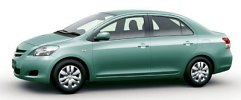 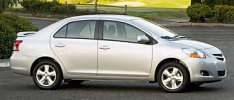
The
sedan version of Vitz / Yaris is called Belta in Japan, or simply Yaris
sedan in the USA. There is no European version because they prefer
hatchback. The sedan is not just a Vitz / Yaris added with a boot, but
it has a longer wheelbase (2550mm vs 2460mm) to offer more rear seat
legroom. However, its rear seat cannot slide back and forth like the
hatchback.
The Belta is powered by either the 1.0 VVT-i or 1.3 VVT-i engine,
coupled to a CVT to emphasize economy. American requires more power, so
Yaris sedan is powered by the 106hp 1.5 VVT-i engine with 5-speed
manual gearbox or 4-speed automatic. |
| The
above report was last updated on 13 Jul 2006. All Rights Reserved. |
Toyota bB
|
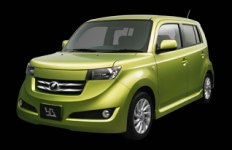 The
first generation bB was named after a scientific concept, Black Box,
because its creator wanted buyers to care about its functions and
practicality instead of frills or gimmicks. It looked really like a
box, but it was popular to the hip-hop generation in Japan and USA,
where it was called Scion xB. The
first generation bB was named after a scientific concept, Black Box,
because its creator wanted buyers to care about its functions and
practicality instead of frills or gimmicks. It looked really like a
box, but it was popular to the hip-hop generation in Japan and USA,
where it was called Scion xB.
The second generation bB was born in December 2005. Style-wise, it
breaks away from the original concept of bB. Although still largely
boxy, the no-nonsense design of the original car is replaced with more
styling
gimmicks. Curves are built into the wheel arches and waistline to tell
us it is not straight-line boring, while the front and rear lights,
bumpers and intakes are no longer satisfied to be pure rectangular. Its
designers obviously wanted to inject more style into the car, which,
ridiculously, contradicts to the meaning of bB. But like the original
car, the styling of new bB divides opinions. Some people think it looks
funky, some regard it bulldog ugly. Myself belong to the latter crowd.
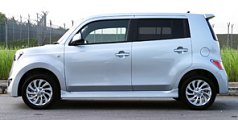 The new
bB is no longer sold in the United States because Toyota America
requested for a larger car. However, it got a new twins brother,
Daihatsu Coo / Materia. Interestingly, Daihatsu claimed it led the
development of both cars. This may explain why the bB looks more like a
Daihatsu than other small Toyotas. However, the twins are built on
Toyota Yaris platform and use all Toyota components, such as the strut
and torsion-beam suspensions, electric power steering, 109hp 1.5-liter
VVT-i engine and 4-speed automatic gearbox. Compare with Yaris, it gets
80mm longer wheelbase as the wheels are pushed closer to the corners.
In addition to the elevated height (105mm taller than Yaris), the new
bB continues to provide a class-leading roomy cabin, especially
headroom. Luggage space is quite small, but the rear
bench can slide back and forth for a range of 220mm (like Yaris) to
liberate more luggage space in the expense of rear legroom. The new
bB is no longer sold in the United States because Toyota America
requested for a larger car. However, it got a new twins brother,
Daihatsu Coo / Materia. Interestingly, Daihatsu claimed it led the
development of both cars. This may explain why the bB looks more like a
Daihatsu than other small Toyotas. However, the twins are built on
Toyota Yaris platform and use all Toyota components, such as the strut
and torsion-beam suspensions, electric power steering, 109hp 1.5-liter
VVT-i engine and 4-speed automatic gearbox. Compare with Yaris, it gets
80mm longer wheelbase as the wheels are pushed closer to the corners.
In addition to the elevated height (105mm taller than Yaris), the new
bB continues to provide a class-leading roomy cabin, especially
headroom. Luggage space is quite small, but the rear
bench can slide back and forth for a range of 220mm (like Yaris) to
liberate more luggage space in the expense of rear legroom.
 If we
talk of practicality, bB may not match an European MAV because its
seating arrangement is not as flexible, nor its storage facilities
worth any special mention. Its centrally-located instrument is silly
and the plastic quality is poor. The interior design is also very ugly.
However, what it really stand out is the audio system. This car has a
second name called "Car-shaped Music Player", according to Toyota. It
provides a CD / harddisk MP3 player with DSP Surround, up to 9 speakers
and 11 flashlights which follow the music beat to illuminate in soft
blue light. To enjoy the music more comfortably, you can drop down and
slide back the front seat by 80mm and 85mm respectively and recline the
seatback to just 20 degrees from horizontal. Close your eyes and enter
the world of Music Player the bB… Yes, this is not a car but a mobile
music player. You buy it
for listening music. If we
talk of practicality, bB may not match an European MAV because its
seating arrangement is not as flexible, nor its storage facilities
worth any special mention. Its centrally-located instrument is silly
and the plastic quality is poor. The interior design is also very ugly.
However, what it really stand out is the audio system. This car has a
second name called "Car-shaped Music Player", according to Toyota. It
provides a CD / harddisk MP3 player with DSP Surround, up to 9 speakers
and 11 flashlights which follow the music beat to illuminate in soft
blue light. To enjoy the music more comfortably, you can drop down and
slide back the front seat by 80mm and 85mm respectively and recline the
seatback to just 20 degrees from horizontal. Close your eyes and enter
the world of Music Player the bB… Yes, this is not a car but a mobile
music player. You buy it
for listening music.
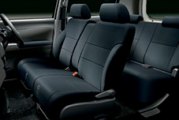 Sorry, maybe I am outdated. I
still can't accept this idea. In my understanding, a car is designed to
be driven. If you tell me a car is a music center, a disco, a video
game center, an internet café, a Wi-Fi kitchen or a multimedia
toilet, then I don't know how to write a review. However, if we talk
about driving, then bB has little to impress. Well, its body control is
not as bad as its tall body suggested due to stiffer suspensions and
longer wheelbase, but its ride quality is average at best. The chassis
rigidity and NVH insulation are not as good as the best superminis. The
steering is too light and lacks feel. Performance is limited by the
combination of the small 1.5-liter engine and 4-speed automatic. The
combination of blocky shape and large frontal area means it struggle to
reach 100 mph. Sorry, maybe I am outdated. I
still can't accept this idea. In my understanding, a car is designed to
be driven. If you tell me a car is a music center, a disco, a video
game center, an internet café, a Wi-Fi kitchen or a multimedia
toilet, then I don't know how to write a review. However, if we talk
about driving, then bB has little to impress. Well, its body control is
not as bad as its tall body suggested due to stiffer suspensions and
longer wheelbase, but its ride quality is average at best. The chassis
rigidity and NVH insulation are not as good as the best superminis. The
steering is too light and lacks feel. Performance is limited by the
combination of the small 1.5-liter engine and 4-speed automatic. The
combination of blocky shape and large frontal area means it struggle to
reach 100 mph.
But then Toyota already got Yaris for sensible people. Silly as it
sounds though, bB does appeal to the new generation of young people
that we
will never understand. |
| The
above report was last updated on 7 May 2007. All Rights Reserved. |
Scion xD / Toyota ist / Urban Cruiser
|
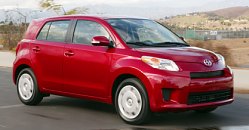 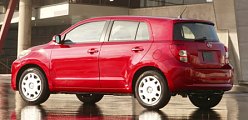 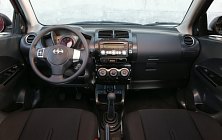
Another
derivative of
Yaris / Vitz is Scion xD, offered exclusively to American. xD replaces
the unsuccessful xA, which was rebadged from the Japanese Toyota ist
and was never designed for the taste of American. This time Toyota
America successfully persuaded its Japanese headquarters to develop the
xD exclusively for the USA market. To resemble the body shape of
average Americans who eat McDonald's meals too often, Scion xD looks
larger, fatter and bulkier than Yaris. It is 180mm longer and 25mm
wider, but unfortunately the wheelbase remains the same as Yaris. This
means cabin space barely increases a little.
Well, size is not everything. If it get more upmarket packaging or
MPV-style flexibility, it may still present meaningful differences.
Unfortunately, Scion xD's cabin is as grey as Yaris. It employs the
same 60/40-split sliding rear seats, so there is hardly any advantages.
The normal positioning of instruments is a welcomed change, but the
dashboard design is rubbish and the plastic materials are no better
than Yaris. The center console is a mess, and the audio fitments looks
like aftermarket. Scion xD reflects American taste only in the way of
its poor taste and poor visual quality.
In mechanical side, there is no advantage over Yaris either. Toyota
American said it has a superior powerplant, Toyota's new 1.8 dual VVT-i
16V engine with 128hp and 125lbft of torque, but this engine already
debuted in the European Yaris TS which carries 65kg less than the Scion
and employs sportier suspension setup and stronger tires. The existence
of Scion xD is rather unnecessary. Seems that it will have a similar
fate to its predecessor.
Addition on 31 Jul
2007:
The Japanese version of this car is Toyota ist. It differs from Scion
xD only by a different grille and the use of a smaller 1.5-liter VVT-i
engine.
Addition on 20 Oct 2008: European version is called Urban Cruiser. It
is powered by either 1.3 VVT-i or 1.4D4-D engine.
|
| The
above report was last updated on 7 May 2007. All
Rights Reserved. |
|
|